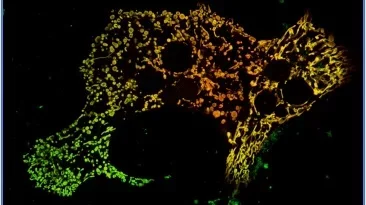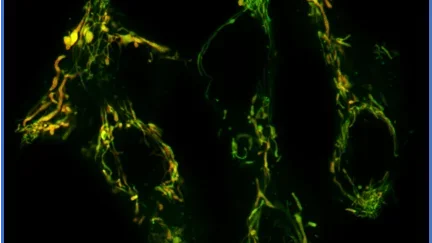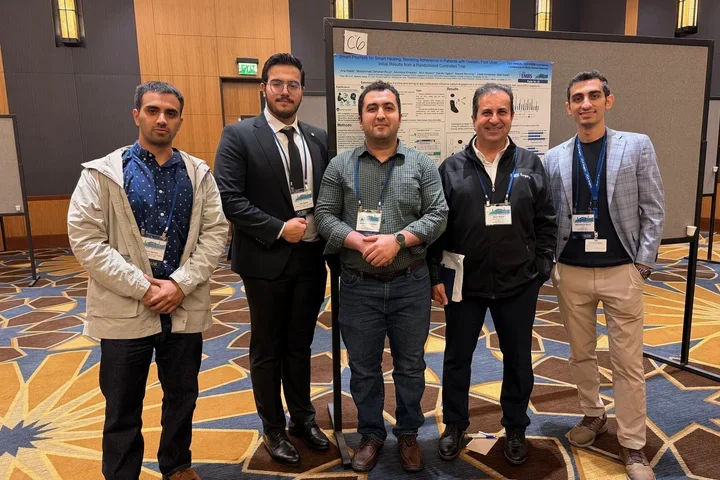Mitochondria Function, Form and Food
Research Spotlight

Pictured above: Top row (left to right): Karel Erion, PhD, Vincent Gutierrez, Anthony E. Jones, PhD. Bottom row (left to right): Orian S. Shirihai, MD/ PhD (Investigator), Jennifer Ngo, PhD (Jenny), Linsey Stiles, PhD, Doyeon Kim-Vasquez.
Within our cells, at any given moment, organelles called mitochondria are hard at work. They convert nutrients from food into adenosine triphosphate (ATP), which our bodies use as energy.
Essential to our complex biological processes, mitochondria themselves are incredibly sophisticated in form and function.
What Is the Function of the Mitochondria?
Mitochondria import thousands of proteins through two membranes to fulfill a variety of mitochondria functions, including, but not limited to:
- Converting food into energy
- Powering a cell’s molecule production
- Managing cell death
- Regulating aging
How Is Mitochondria Structure Connected to Food?
Thanks to technological advances enabling the closer examination of mitochondria, researchers are constantly learning more about the nuanced ways they function. (That they work much like Tesla battery packs, for example.)
Orian Shirihai, MD, PhD, and his team recently observed that mitochondria behave a lot like trains.
Much like trains deliver cargo and passengers from one place to another, mitochondria deliver fuel (energy converted from food) to different parts of a cell.
They’re also shapeshifters.
Dynamic mitochondria combine and divide, altering form to accommodate changing energy needs. When faced with excess nutrients, they break into smaller pieces in a process called mitochondrial fragmentation.


An Analogy for Mitochondrial Fragmentation
The train analogy extends to mitochondrial fragmentation. If mitochondria move around cells like trains, then the fragmentation of mitochondria into smaller segments is like trains dividing to avoid obstacles on the tracks.
In the mitochondrial world, each fragmented train car can move around independently as its own autonomous vehicle.

Discovering a Link to Metabolic Diseases

Recently, separate research teams (from UCLA, Chungnam National University, and Harvard Medical School), all curious about mitochondrial fragmentation, teamed up to better understand the process.
They found that the fragmented parts of mitochondria, the smaller “train cars,” demonstrated enhanced fat-burning efficiency. The added efficiency decreased if the fragments fused with other small cars.
The mitochondria exhibited the same operational challenges you might witness on a train. Smaller trains with fewer passengers are easier for conductors to regulate.
The correlation between fragmentation and increased fat-burning was clear. Next, the teams began defining the mechanisms driving that correlation.
They noticed that the mitochondria structure change that occurred during fragmentation also altered the regulation of fat-importing proteins on the mitochondrial membrane. In other words, mitochondrial architecture was the mechanism driving the change in fat usage.
This suggests mitochondrial shape may play a central role in metabolism as well as the development of metabolic diseases.
The Future of Treating Metabolic Disease
The tendency for the structure of mitochondria to dictate the use of fat for energy was confirmed in several tissue models. Because increased fat utilization is associated with many pathologies, this discovery may lead to new ways to address diseases, including mitochondrial metabolic diseases.
“These findings highlight a hitherto unappreciated role for mitochondrial fragmentation in basic metabolic regulation beyond its well-known relevance in clearance of damaged mitochondria through mitophagy,” says Orian Shirihai, MD, PhD.
About the study
The study was published in EMBO journal.
The study’s first authors are Jennifer Ngo of the Department of Medicine, Division of Endocrinology at the David Geffen School of Medicine at UCLA (DGSOM) and Dong Wook Choi, assistant professor of Chungnam National University. Dr. Orian Shirihai is a co-corresponding author of the paper, along with Dr. Nika Danial, associate professor of medicine at the Dana-Farber Cancer Institute, Harvard Medical School. A full list of authors may be found in the journal article.
Funding for the study was provided by the National Institutes of Health, National Cancer Institute, National Institute of Diabetes, V Foundation for Cancer Research, Claudia Adams Barr Program in Innovative Basic Science Research Program, and the South Korean National Research Foundation.



